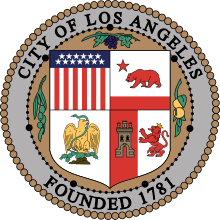South Robertson, Los Angeles
South Robertson (also referred to as Pico-Robertson) is a neighborhood in the Westside of the city of Los Angeles, California. It is notable for its diversity and being a center for the Jewish community.
South Robertson | |
|---|---|
Neighborhood of Los Angeles | |
Bnai David Judea building, a prominent sight in Pico-Robertson, once the home of Fox Stadium theatre | |
| Country | United States |
| State | California |
| County | Los Angeles |
| City | Los Angeles |
| Time zone | UTC-8 (PST) |
| • Summer (DST) | UTC-7 (PDT) |
| ZIP Code | 90019, 90035, 90036 |
Geography
Description
According to the Mapping L.A. project of the Los Angeles Times, Pico-Robertson is flanked on the north and northeast by Beverly Hills, on the east by Carthay and Mid-City, on the south by Mid-City, Crestview, Beverlywood and Cheviot Hills and on the west by Beverly Hills.[1]
Pico-Robertson's street borders are: north, Gregory Way and Pico Boulevard; northeast, LeDoux Road and Olympic and San Vicente Boulevards, roughly Beverly Glen Drive;[2] east, La Cienega Boulevard, Fairfax Avenue and Hauser Boulevard; south, Airdrome Street, Hillcrest Country Club, Venice, National and Washington Boulevards; west, Robertson Boulevard, Beverly Green Drive and S. Roxbury Drive.
Population
The 2000 U.S. census counted 18,019 residents in the 1,03-square-mile Pico-Robertson neighborhood—an average of 17,468 people per square mile, among the highest population densities for the city. In 2008, the city estimated that the population had increased to 19,253. The median age for residents was 36, older than the city at large; the percentages of residents aged 19 to 34 and 65 and older were among the county's highest.[2]
The neighborhood was considered "not especially diverse" ethnically, with a high percentage of white people. The breakdown was whites, 73.5%; Latinos, 7.3%;Asians, 5.7%; blacks, 5.6%; and others, 7.9%. Iran (37.2%) and Israel (5.7%) were the most common places of birth for the 34.6% of the residents who were born abroad—about the same percentage as in the city at large.[2]
The median yearly household income in 2008 dollars was $63,356, an average figure for Los Angeles. The average household size of 2.1 people was low for Los Angeles. Renters occupied 73.1% of the housing stock and house- or apartment owners held 26.9%.[2]
Adjacent neighborhoods
Beverlywood, Cheviot Hills and Crestview on the Southwest, Mid-City on the Southeast, Mid-Wilshire on the East, Mid-City West on the North, Beverly Hills on the Northwest and Century City on the West.
Education
Part of the Los Angeles Unified School District, the neighborhood is served by Canfield, Crescent Heights, Shenandoah, and Castle Heights elementary schools, Los Angeles Center for Enriched Studies and Emerson Middle School. The high school for the South Robertson neighborhood is Hamilton High School.
Jewish community
The neighborhood features more than thirty certified kosher restaurants,[3] including delis, Chinese, Italian and Mexican restaurants, a donut shop, a frozen yogurt shop, bakeries, and butchers. The community features four men's mikvahs and one woman's mikvah, the largest known as the Los Angeles Mikvah.
There are several Jewish day schools located in the Pico-Robertson area. The Chabad community operates four schools, Bais Chaya Mushka and Bais Chana, both of which are on Pico Boulevard, as well as the newly relocated Cheder Menachem on La Cienega. Yeshiva University High School has campuses on both South Robertson Boulevard and West Pico Boulevard.
The community overall has a wide variety of Jewish denominational groups. Over the past two decades, the Orthodox community has grown to become the largest Jewish denomination in the area. This is evident in the growth of the Chabad community.
According to Chabad,[4] the Hasidic movement has eleven centers in the immediate Pico-Robertson area, including the two high schools, boys cheder, day school, six synagogues, and a community center. Minyan Finder reports over twenty synagogues operating in the area.[5]
In 1993, the neighborhood became home to the Los Angeles Museum of Tolerance.
References
- Colored map, Mapping L.A., Los Angeles Times
- "Pico-Robertson," Mapping L.A., Los Angeles Times
- "Respectable Reviews". kosherla.info.
- "Chabad.org". www.chabad.org.
- "goDaven! Minyanim Everywhere". www.godaven.com.

